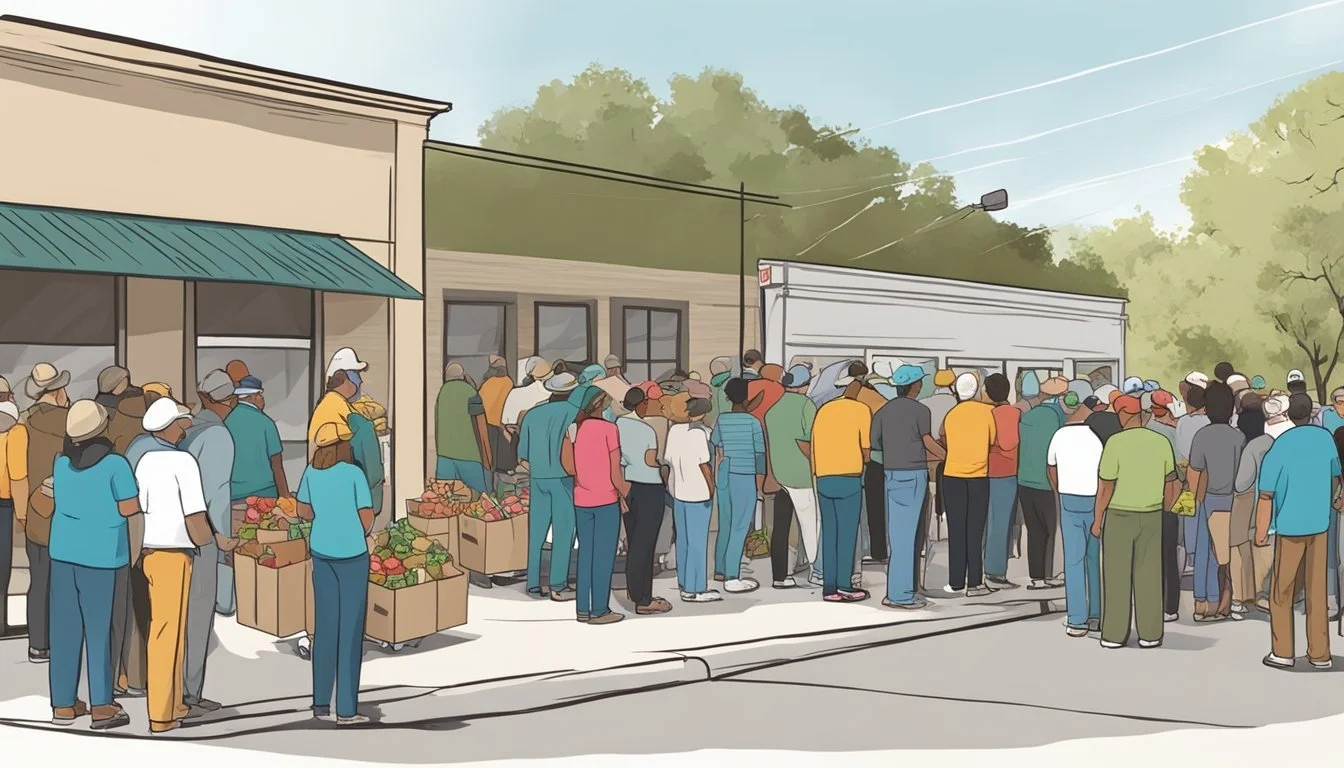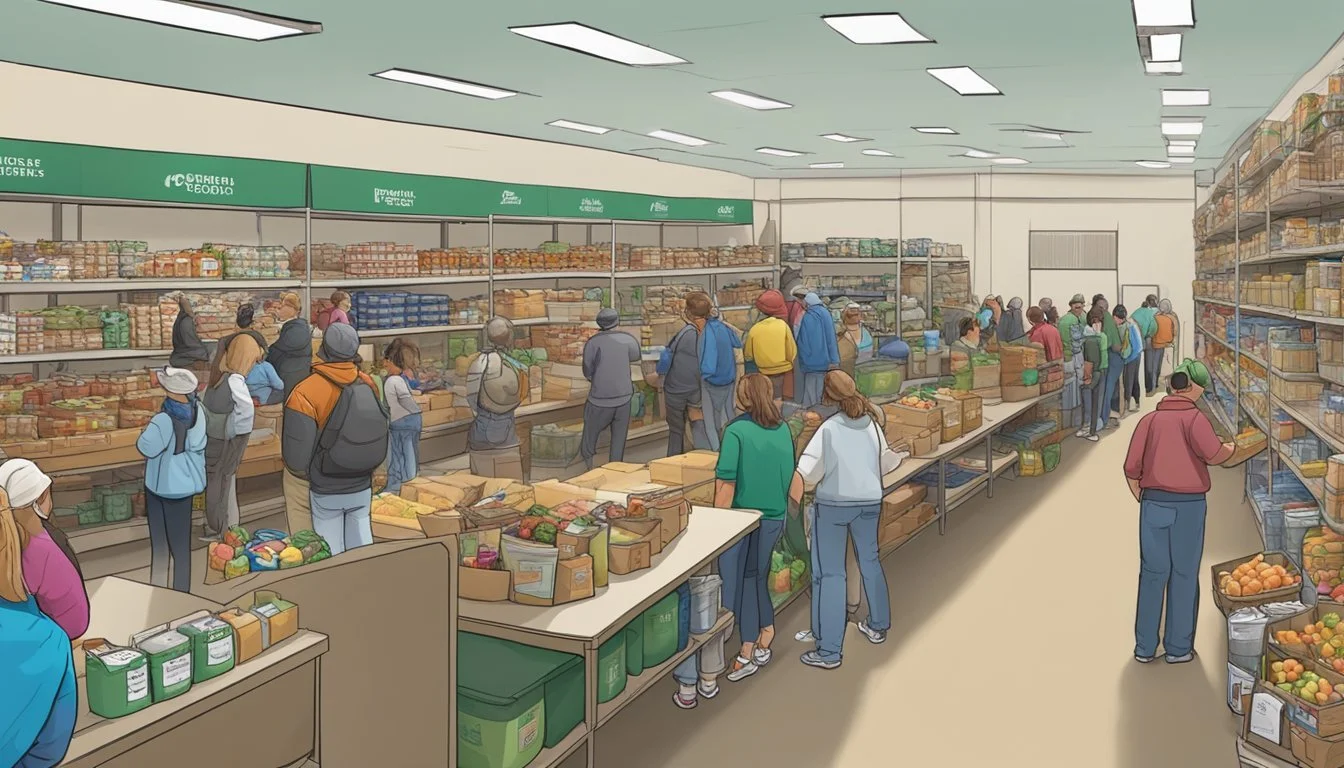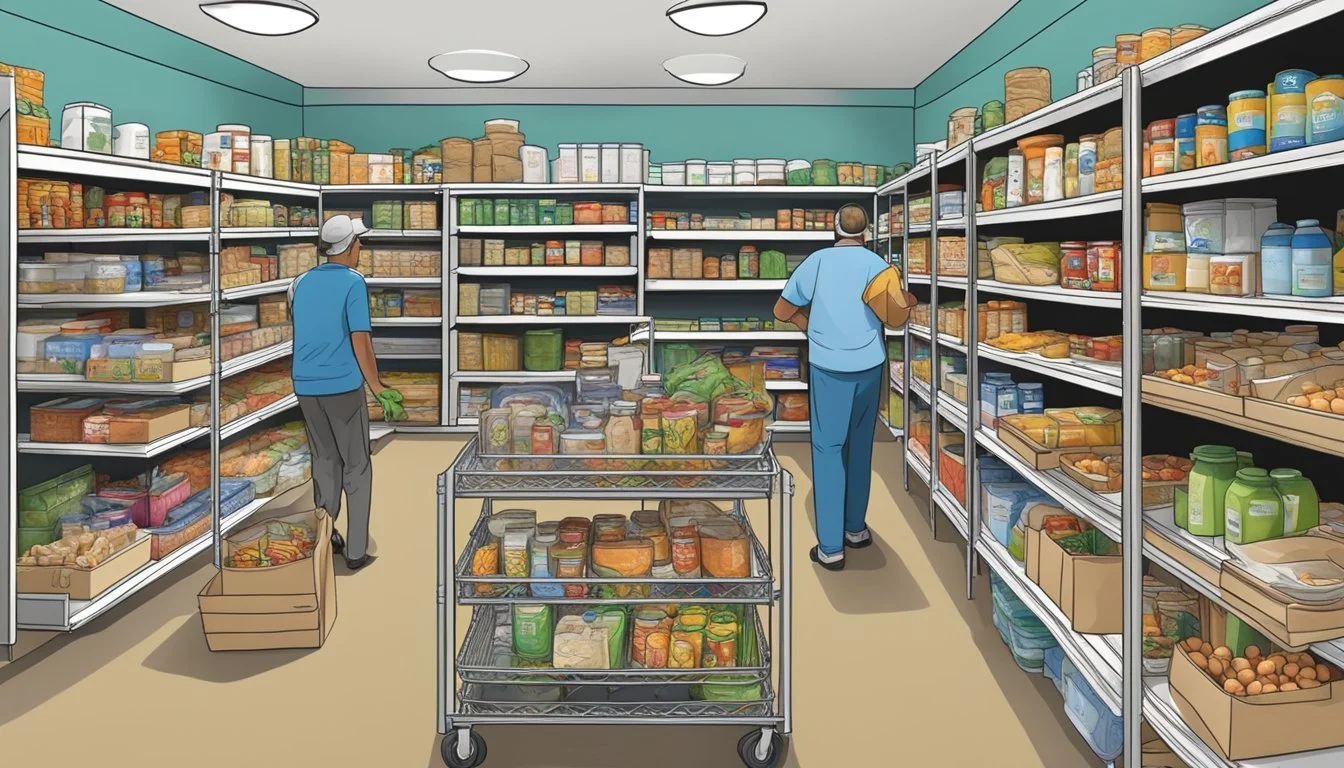Free Groceries and Food Pantries in Edwards County, Texas
A Guide to Local Assistance Programs
This Article is Part of Our Guide on Free Groceries in Texas
In Edwards County, Texas, residents facing food insecurity have the opportunity to access free groceries and food assistance through a variety of food pantries. These community-supported resources ensure individuals and families can obtain nutritional foods despite financial challenges. Designed to provide a safety net, these pantries serve as a reliable source of sustenance and often operate in partnership with local organizations, including Feeding America.
The concept of a food pantry is simple: it acts as a centralized location where eligible community members can go to receive food at no cost. Some pantries offer drive-thru services, adding a layer of convenience for recipients by allowing them to receive pre-selected groceries without leaving their vehicles. Meanwhile, mobile food pantries enhance accessibility further by bringing food directly to people in different locations within the county, reaching those who might otherwise be unable to travel to a static site.
Edwards County's network of food assistance programs typically outlines clear eligibility requirements and hours of operation, facilitating a streamlined process for residents to get the help they need. By entering a zip code on partner websites, individuals can quickly connect to the nearest food bank and discover local pantries' schedules, ensuring that the process of finding free food and groceries is both user-friendly and efficient.
Understanding Food Insecurity in Edwards County
Edwards County faces challenges in ensuring all residents have consistent access to nutritious food. This section explores the nature and scope of food insecurity in this rural area.
Defining Food Deserts
A food desert is an area where residents have limited access to a variety of healthy and affordable food options. In Edwards County, a food desert may be characterized by a shortage of grocery stores within a convenient traveling distance. Individuals living in these areas might find it necessary to rely on food banks or food pantries to fill the gap. The presence of a food desert often correlates with higher levels of food insecurity.
Prevalence of Food Scarcity
Food scarcity in Edwards County can be evidenced by the number of individuals seeking assistance from food banks and local food pantries. Food scarcity refers not only to a lack of food but also to a lack of nutritious food options. For instance, even if caloric foods are available, they might not meet the dietary needs of the residents for a healthy life. Food pantries in Edwards strive to provide balanced food options, but the demand often reflects the challenges residents face in obtaining sufficient nourishment on a regular basis.
Local Food Banks Overview
Local food banks in Edwards County, Texas, provide essential services to community members in need, offering free groceries and support. They operate on specific hours and can be reached through various channels for assistance.
Services Offered
Local food banks offer a range of services aimed at addressing food insecurity. These usually include:
Distribution of Free Groceries: A selection of staple food items and fresh produce.
Nutritional Programs: Such as SNAP application assistance.
Specialized Services: Like drive-thru pantries for easy and convenient food collection.
Hours of Operation
The hours of operation vary between different food banks in Edwards County. A typical schedule is:
Weekdays: 9:00 AM – 5:00 PM
Weekends: Some food banks open on Saturdays, usually in the morning hours.
It's advisable for individuals to confirm the hours by contacting the specific food bank as they may have unique schedules or additional services like after-hours assistance.
Locations and Contact Information
The precise locations and how to reach food banks in Edwards County are critical for accessing their services. Below is a table with hypothetical examples of local food banks, their locations, and contact methods:
Food Bank Name Address Contact Information Edwards Community Food Bank 123 Charity Lane, Rocksprings, TX (555) 123-4567 Rocksprings Food Assistance 456 Helping Hand Rd, Rocksprings, TX info@rockspringsfood.org
For more detailed information on additional locations and services, individuals should contact their local food bank directly.
Free Pantry Eligibility and Access
Food insecurity is a pressing issue, and Edwards County, Texas, offers several resources to aid individuals and families in need. Food pantries and assistance programs have specific eligibility requirements and multiple access points for those who need free groceries and food items.
Eligibility Requirements
In Edwards County, individuals seeking food assistance are typically required to meet certain criteria to qualify for help from food pantries. Common eligibility factors include:
Residency: One must be a resident of Edwards County.
Income: Income levels often determine eligibility, usually set below specific thresholds.
How to Access Food Support
To obtain food support in Edwards County, individuals can:
Find Local Food Pantries: Utilize resources like Feeding America to locate nearby food banks or pantries.
Drive-Thru Pantries: For convenient pick-up, some locations offer drive-thru services where pre-packed boxes or bags are loaded directly into vehicles.
Referrals and Case Managers
Referrals: Typically obtained from social service agencies or nonprofits, referrals can direct individuals to the appropriate food assistance programs.
Case Managers: They play a pivotal role in assisting with applications for food support programs and may provide ongoing guidance to navigate different types of assistance available.
Soup Kitchens and Hot Meal Programs
In Edwards County, Texas, residents in need can find comfort and sustenance in local soup kitchens and meal programs that offer hot meals. These services are fundamental for supporting individuals and families experiencing food insecurity, providing them not just with nutrition, but also a communal space to dine.
Meal Distribution Locations
Soup kitchens and meal programs in Edwards County operate in various locations, including churches, community centers, and shelters. They offer hot meals to anyone in need, ensuring that nobody in the community has to go hungry. These establishments typically have set hours of operation and may require individuals to sign in, but no one is turned away due to an inability to pay.
Edwards County Community Center: Open weekdays, serves lunch from 12 PM to 2 PM.
St. Martha's Church Soup Kitchen: Offers dinner on Mondays and Thursdays, 5 PM to 7 PM.
Special Holiday Meals
The holiday season can be particularly challenging for those struggling to make ends meet. Soup kitchens and meal programs in Edwards County understand the importance of community during these times and often host special meals for Thanksgiving and Christmas.
Thanksgiving Day Feast: Hosted by local volunteers at the Edwards County Community Center, with meals served from 11 AM to 3 PM.
Christmas Eve Dinner: St. Martha's Church Soup Kitchen welcomes all for a festive meal from 4 PM to 6 PM, featuring traditional holiday fare.
These holiday events not only provide a hot meal but also foster a sense of togetherness and celebration in line with the spirit of the season.
Additional Nutritional Assistance Programs
In Edwards County, Texas, beyond food pantries, residents can take advantage of other nutritional assistance programs designed to meet the needs of diverse populations, including low-income families, the elderly, and children.
SNAP Food Stamps and WIC
Supplemental Nutrition Assistance Program (SNAP), formerly known as food stamps, is a federal assistance program that provides monthly benefits to eligible individuals and families to help them buy food. In Edwards County, Texas, residents can apply for SNAP benefits through the state's Health and Human Services Commission.
Who is eligible?: Low-income individuals and families.
How to apply?: Applications can be submitted online, via mail, or in person.
Women, Infants, and Children (WIC) is a nutrition program that helps pregnant women, new mothers, and young children eat well, learn about nutrition, and stay healthy. WIC provides nutritional education, breastfeeding support, and benefits for purchasing specific healthy foods.
Who is eligible?: Pregnant women, breastfeeding women up to the infant's first birthday, women up to six months postpartum, and children under the age of five.
How to apply?: Contact the local WIC office in Edwards County.
Meals on Wheels for Seniors
Meals on Wheels programs support seniors in Edwards County, offering nutritious meals delivered directly to their homes. These programs are designed to address hunger and isolation among the elderly population.
Who is eligible?: Seniors, typically those aged 60 and over or disabled adults who are homebound.
How to access the service?: Interested individuals should reach out to the nearest Meals on Wheels provider for enrollment details.
Community and Government Resources
In Edwards County, residents facing food insecurity can rely on a network of support offered through local charities and churches, as well as federal and state-funded programs. Here, community collaboration and governmental assistance play a vital role in aiding those in need.
Local Charities and Churches
Local charities and churches in Edwards County form the backbone of immediate food relief efforts. These organizations operate food pantries and may provide meals to individuals and families facing hardship. They typically have varying hours of operation and may have certain eligibility requirements. Such entities often depend on donations and volunteers to sustain their services.
Grace Food Pantry: A major provider, available for emergency distributions. For operation times, contact directly.
Organization Location Contact Number Services Offered Grace Food Pantry 10.35 miles from Edwards (315) 287-7656 Emergency food distributions
Federal and State Support
At the federal and state level, programs like SNAP (Supplemental Nutrition Assistance Program) help residents supplement their food budgets and make ends meet. These governmental initiatives often connect individuals with broader networks to address food scarcity, providing resources beyond immediate local reach.
Feeding America: A national network, which helps in locating local food banks through ZIP code search.
Program Description Access Method SNAP Federal assistance to supplement food budgets Apply through state agencies Feeding America Nationwide network of food banks Search by ZIP on their website
Residents interested in these programs should visit their local county office or state website for more detailed information on eligibility and application procedures.
Specialized Support Services
Specialized support services in Edwards County provide targeted assistance to specific groups in need, ensuring that every resident can access nutritious food options, regardless of their background or current circumstances.
Programs for Immigrants and Veterans
Edwards County recognizes the unique challenges faced by immigrants and veterans and offers programs tailored to their needs. Immigrants can find assistance through culturally sensitive services that address language barriers and familiarize them with available resources. Veterans benefit from dedicated programs that acknowledge their service, offering expedited access to food assistance and support designed to honor their contributions to the country.
Immigrant Support: Multilingual assistance, SNAP application guidance
Veteran Support: Priority pantry access, assistance with VA benefits coordination
Support for Low-Income and Homeless Individuals
Food pantries in Edwards County provide essential support to low-income and homeless individuals. They operate with a clear understanding that accessibility and reliability are crucial for individuals and families facing economic hardships.
Low-Income Support: Income-based aid, consistent pantry schedules
Homeless Individuals' Aid: No-residency-required distributions, ready-to-eat food options
Supportive food pantries make use of federal programs and local initiatives to create a safety net that addresses both immediate needs and long-term food security for these vulnerable populations.
Volunteer and Donation Opportunities
Engaging with local food banks and distribution centers offers crucial support in the fight against hunger. Individuals have the power to make a significant impact through volunteering or organizing food drives.
How to Contribute Locally
Volunteers are instrumental in the operations of local food banks, with options to help in various capacities. Those interested in lending their time can find opportunities by reaching out to their nearest food bank. Many food banks, such as those in the Feeding America network, list available volunteer shifts on their websites. It's an opportunity not only to contribute to an essential cause but also to join a community united in helping others.
Find a food bank: Use available search tools to locate a food bank in the area.
Sign up: Choose a volunteer shift that fits into your schedule.
Participate: Show up at the nominated time and take part in the food bank's activities.
Organizing Food Drives
Organizing a food drive is another effective way of contributing to local food banks and distribution centers. Corporate donors can play a significant role, mirroring the efforts of businesses like Dollar General and Walmart, which have established partnerships for regular food donations. Here is a straightforward guide to setting up a successful food drive:
Plan: Decide on the timeline and logistics for the food drive.
Partner: Engage local businesses and community members for support.
Promote: Use social media and local outlets to spread the word.
Proceed: Collect the donated items and coordinate with your local food bank for distribution.
Food drives can have a notable impact on the inventory of a food bank, ensuring a steady supply of groceries for those in need.
Finding Help Online
In Edwards County, Texas, individuals seeking assistance with obtaining free groceries and accessing food pantries have a variety of online resources at their disposal. These tools offer updated directories and search capabilities to find local help effectively.
Online Directories and Maps
Most food assistance resources are listed in online directories. One prominent source is Feeding America which provides an extensive network of food banks and a map with pinpoint locations. Users can enter their zip code or city to see a list of nearby facilities. Additionally, websites like foodpantries.org compile both government and non-profit subsidized grocery options. The search results there typically include the hours of operation, contact information, and types of assistance offered.
Example Directory Entry:
Edwards County Food Bank
Address: [Insert Physical Address]
Hours: Mon-Fri, 9am-5pm
Services: Emergency food boxes, SNAP application assistance
Search Tips for Accurate Results
When utilizing online directories to secure food assistance, certain search strategies can enhance the accuracy of results. First, specify the location by entering the exact city or county followed by the state abbreviation to avoid confusion with places of the same name in other states. Additionally, users should filter results based on their specific needs, such as "drive-thru pantries" or "low-income assistance," as many directories offer these functionalities. Critical keywords, when input correctly, will yield the most relevant search results.
Example Search Query:
"Food pantries in Edwards County, TX"
Relevant Filters: Low income, Family size, Dietary preferences
By leveraging online directories and using effective search techniques, individuals in Edwards County can access current information on free food resources available to them.
Comprehensive Guides and Resources
For those seeking food assistance in Edwards County, Texas, comprehensive guides and resources are readily available. These guides provide crucial details such as printable lists, addresses based on zip codes, and visual representations of pantry offerings.
Printable Lists and Address Information
The cornerstone of accessible food assistance resources is a well-organized printable list. These lists typically include names and addresses of food pantries, sorted by zip code to facilitate easy location by residents. Guides may also highlight operating hours and qualification requirements for each pantry. Residents can usually obtain these printable lists from local community centers or download them from dedicated food assistance websites.
Visual Guides with Pantry Pictures
Visual guides enhance the experience of selecting a food pantry by providing pictures that showcase the facilities and available food items. Such guides help individuals to familiarize themselves with the pantries before their visit, easing the process of obtaining assistance and making the experience less intimidating. Pantry pictures can often be found included within comprehensive guides, alongside essential details like services offered and location addresses.












